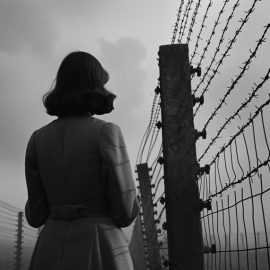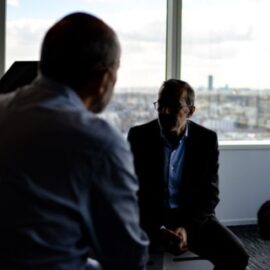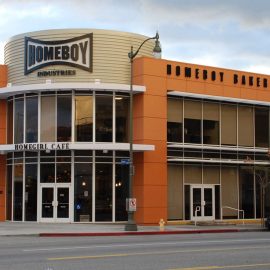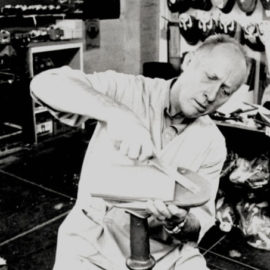

This article is an excerpt from the Shortform summary of "Unbroken" by Laura Hillenbrand. Shortform has the world's best summaries of books you should be reading.
Like this article? Sign up for a free trial here .
Why was Louis Zamperini nicknamed the “Torrance Tornado?” How did he get this nickname?
Once a troubled child known for criminal behavior and trouble making, Louis Zamperini channeled his energy into his running career. Locally, he became known as the “Torrance Tornado” by all the people who followed his career. The Torrance, California community believed in Louis’s running career and rooted relentlessly for their “Torrance Tornado.”
The Town Terror Becomes The Torrance Tornado
Long before Louis Silvie Zamperini was an Olympic athlete and soldier in WWII, he was a child criminal no one knew how to handle. Born to Italian immigrants in New York in January 1917, he was the second of what would become four children. His parents were Anthony, a coal miner and boxer, and Louise, who had Louis when she was 18. After Louis came down with pneumonia at the age of two, the family moved to Southern California to live in warmer weather.
The family moved to the town of Torrance just south of Los Angeles. In Torrance, Louis’s antics earned him the reputation of being the town terror. He once ran across a busy highway and was almost run over. At five, he started smoking cigarette butts found on the street. At family dinners, he climbed under the table and stole his parents’ glasses of wine. One night, he grew so inebriated, he fell into a rosebush in the yard. On another, he almost drowned in a refinery well after diving off the top of an oil rig. When they pulled him out, he was covered in oil.
After several frightening experiences, Louis had a wake up call. All of the effort Louis had put into plotting and scheming now went into running. He no longer ran to escape trouble or an altercation. He ran because it was what started to feel the most natural.
With his world suddenly falling into a cathartic focus, Louis’s body and behavior worked to reach their potential. He quit boozing and smoking and worked on increasing his lung capacity by submerging himself in the local pool in Redondo Beach, sometimes for as long as three and a half minutes. He was on his way to becoming the “Torrance Tornado,” and he was determined to make something of himself.
Louis also became interested in the career of a runner from the University of Kansas, Glenn Cunningham. Cunningham had survived a tragic accident and had to teach himself how to walk again, then run. He was quickly becoming a legend in the making for his prowess in the mile. Louis idolized him.
Racing Toward Destiny
Pete joined the track team of a junior-college in Compton, but he didn’t release his self-imposed duty as Louis’s personal trainer. He came home on a regular basis and taught Louis about form and the psychology of running.
Pete also recognized a special physical component of Louis’s body. Louis’s hips were configured in a way that allowed them to roll as he ran, which meant his next step was already forming as the first step was landing. This trait gave him a massive stride, about seven feet long. This advantage was of most benefit in longer races. Pete wanted Louis to become a miler.
The Torrance Tornado Sets His Eye on the Ultimate Prize
Louis’s stature as a legend was cemented his junior year at the Southern California Track and Field Championship. He set a national high school mile record that day at 4:21.3, two seconds faster than the previous record held since WWI. One report said it was unlikely his record would be broken within the next twenty years. The reporter was only off by one year.
Louis’s success made the community of Torrance change their feelings about him. Where once he was the town terror, now he was a local hero. His life became an embarrassment of riches. People lined up for autographs, and he received so many wristwatches as prizes, he started giving them away to neighbors. Girls swarmed him, and the press took photos of him and his trophies in front of his house.
Watching Louis train became a spectator sport at the track, and people started referring to him as “Iron Man” and the “Torrance Tornado.” Newspapers from all over Southern California were pumping out stories about this budding superstar, including the LA Times and Examiner.
For the boy whose only thought used to be what to steal next, Louis’s life now encompassed bigger dreams. He started to believe his legs could take him all the way to the world’s stage. He set his sights on the Berlin Olympics in 1936.
Louis’s Olympic dream required an adjustment in his training. There was no mile race, only the 1500, 100 meters shorter. Many of the Olympic runners would be older, around their mid-20s, including Louis’s hero, Glenn Cunningham, who would be twenty-seven by the 1936 games. In comparison, Louis would only be nineteen.
None of these factors deterred Louis, who’d already become the best high school miler ever in America. Over the two years that Louis had been competing, he’d shaved 42 seconds off his mile time. Louis was determined to make it to Berlin, and once he completed his undefeated senior season, the experts started to think he might just do it.
After graduating from high school in 1935, scholarship offers from a multitude of top schools came flooding in. Pete had transitioned to USC on a scholarship and was making his mark as one of the best milers in the country, as well. He urged Louis to accept their offer but defer until after the Olympic trials seven months away. Louis agreed and went to live with Pete so they could continue their training partnership.
Louis was a ferocious trainer, working with Pete every day to get in shape for the 1500. But his dream ended in the spring when he realized he wasn’t improving fast enough. Louis was too young, and there was no way to make his body mature to the level of his competition. He was crushed.
Competing in Front of the World
Louis’s confidence and brashness in the face of obstacles as a child would come to be his saving grace after losing his dream of racing in the 1500 in Berlin. Louis saw an article about an upcoming meet at the Los Angeles Coliseum. A twenty-six-year-old schoolteacher, Norman Bright, was touted as one of the favorites in the 5,000 meters race. Bright had the second-best time behind a younger racer from Indiana named Don Lash.
Louis learned that three 5,000-meter runners would go to the Olympics. Pete pushed him to enter the race, despite its extended distance of just over three miles. If Louis could keep up with Bright, he’d have a shot at making the team. With only two weeks until the meet and having never run farther than a mile twice in high school, Louis knew it was a long shot. But Louis was nothing if not a fighter. He trained so intensely, he lost the skin off one of his toes.
Louis would learn just what he was made of during that race and live up to his “Torrance Tornado” nickname In front of 10,000 fans, Bright and Louis ran neck and neck the whole way. Although Bright finished a heartbeat ahead of Louis, both their times were faster than the previous record of that year.
With his Olympic dream suddenly a reality again, Louis strived for greatness at this new distance. He succeeded at his second qualifier in June 1936, clocking the third-fastest time in the country. Louis was invited to the Olympic trials in New York.
Though Louis’s running career would never take him back to the Olympics after 1936, his reputation as the “Torrance Tornado” made him a local legend. He was honored in his hometown upon his return from the war, and found that his community was excited to welcome back their “Torrance Tornado” for good.

———End of Preview———
Like what you just read? Read the rest of the world's best summary of Laura Hillenbrand's "Unbroken" at Shortform .
Here's what you'll find in our full Unbroken summary :
- How Louie Zamperini was on track to become an Olympic athlete until the war started
- The unbelievable story of his capture as a prisoner of war
- The ultimate fate of Louie and his captors






